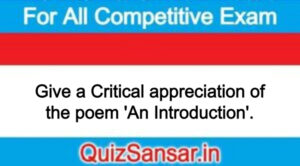
Give a Critical appreciation of the poem ‘An Introduction’.
Give a Critical appreciation of the poem ‘An Introduction’.
Ans.
“An Introduction’ is a confessional poem by Kamala Das. The poem is also a poem of protest against the conventions of society and against restraints and restrictions which husbands or society in general impose upon women. It implies, not only her pursuit and her attainment of the freedom to act just as she likes but also her advocacy of the right of all women to enjoy such freedom.
An Introduction voices the poet’s quests for identity and fulfilment. It raises the question of human identity, but it effectively uses the confessional and the rhetorical modes in order to focus pertinent questions relating to a woman’s or an Indian poet’s identity in English. Her sense of alienation finds a most striking expression in the poem. In this poem, she first refers, in a sarcastic and intensely censorious manner, to those critics, friends and visiting cousins who urged her not to write poetry in the English language because this language was not her mother tongue. Kamala Das reply to this advice is that she would write in any language she likes. Whichever language she uses, would becomes hers, with all its distortions and its queerness. This sense of alienation from her friends and cousins voices her protest against people who think that Indians should not write poetry in English.
She had expressed her strong dissatisfaction with her married life, she has protested against the passivity and timidity of the Indian woman and against her subservience to her husband. She complains resentfully in this poem, that her husband had treated her in the most cruel manner in the course of the sexual act due to which she felt as if if she had been badly beaten, and that the weight of her breasts and womb and crushed her. There lines show Kamala’s uninhibited manner of speaking about sex and about her physical organs.
The poem reveals Kamala’s desire to be even with the male world, in the following lines:
Then ……….I wore a shirt and my
Brother’s trousers, cut my hair short and ignored
My womanliness
Again she complains about people who want her to conform to their notions of a good life. They had urged her to behave like a girl, to behave like a wife, to take to embroidery, to do the cooking, to quarrel with servants. They had compelled her to stay within the traditional feminine shell. They had even alleged that she had been pretending to be a schizophrenic and then a nymphomaniac.
And then finally, conies the realization that her experiences are the experiences of every woman:
I met a man, loved him. Call
Him not by any name, he is every man
Who wants a woman, just as I am every
Woman who seeks love. In him…… the hungry haste
Of rivers, in me……….the ocean’s tireless
Waiting.
There is passivity as well as rebellion against a male dominated world. In the end she feels that she, like all other human beings had been a sinner as well as a saint. She had been loved as well as betrayed in love. She has the same joys in life which others have, and that she suffers the same disappointments which others suffer.
In this short poem, Kamala has given us a self portrait and the anatomy of her mind, recounting the major incidents of her life and the experiences which had affected her most till the time of her writing this poem. The poem is remarkable for its compression and compactness of its structure even though it contains a diversity of facts and circumstances. The rules of punctuation have been fully observed; all the lines are almost of the same length. The words used and the phraseology show Kamala’s talent for choosing the right words and putting them in highly satisfactory combinations. Indeed, the poem-contains many felicities of word and phrase. It also reveals a mastery of, and control over, rhythm, and employs the rhythms of conversational speech as in the following lines.
Be Amy, or be Kamala. Or, better
Still, be Madhavi kutty. It is time to
Choose a name, a role.
And then the poem moves suddenly into the urgent driving rhythm which is characteristic of some of Kamala’s best work:
Who are you, I ask each and every one
The answer is it is I, Anywhere and
Everywhere, I see the one who calls himself
In this poem, Kamala gives us a vivid picture of how she grew up from a child to an adult, becoming tall, with her limbs swelling or becoming bigger and hair sprouting at one or two places in her body.
-
Write the critical appreciation of the poem No. 12 entitled Far Below Flowed.
-
Write the critical appreciation of the poem No. 11 entitled Leave this Chanting.






